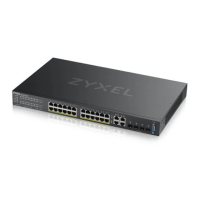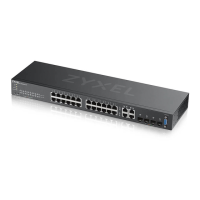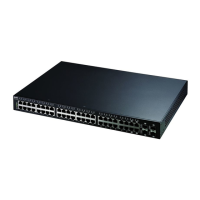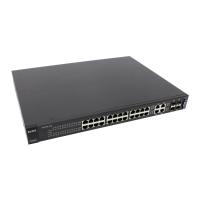Chapter 13 Spanning Tree Protocol
GS2220 Series User’s Guide
177
Fig ure 140 Advanced Application > Spanning Tree Protocol > Status: MRSTP
The following table describes the labels in this screen.
Table 72 Advanced Application > Spanning Tree Protocol > Status: MRSTP
LABEL DESCRIPTIO N
Configuration Click Co nfig ura tion to specify which STP mode you want to activate. Click MRSTP to edit
MRSTP settings on the Switch.
Tree Select which STP tree configuration you want to view.
Bridge Ro o t refers to the base of the spanning tree (the root bridge). Our Bridg e is this switch. This
Switch may also be the root bridge.
Bridge ID This is the unique identifier for this bridge, consisting of bridge priority plus MAC address. This ID
is the same for Ro o t and O ur Bridg e if the Switch is the root switch.
Hello Time
(second)
This is the time interval (in seconds) at which the root switch transmits a configuration
message. The root bridge determines He llo Tim e , Ma x Ag e and Fo rwa rding De la y.
Max Age (second) This is the maximum time (in seconds) the Switch can wait without receiving a configuration
message before attempting to reconfigure.
Forwarding Delay
(second)
This is the time (in seconds) the root switch will wait before changing states (that is, listening to
learning to forwarding).
Note: The listening state does not exist in RSTP.
Cost to Bridge This is the path cost from the root port on this Switch to the root switch.
Port ID This is the priority and number of the port on the Switch through which this Switch must
communicate with the root of the Spanning Tree.
Topology
Changed Times
This is the number of times the spanning tree has been reconfigured.
Time Since Last
Change
This is the time since the spanning tree was last reconfigured.
Port This field displays the number of the port on the Switch.
Port State This field displays the port state in STP.
• Disc a rding – The port does not forward or process received frames or learn MAC
addresses, but still listens for BPDUs.
• Le a rning – The port learns MAC addresses and processes BPDUs, but does not forward
frames yet.
• Fo rwa rding – The port is operating normally. It learns MAC addresses, processes BPDUs
and forwards received frames.

